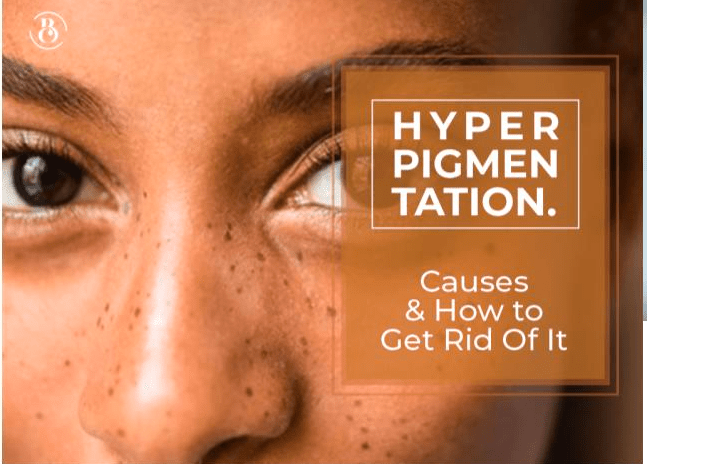Hyperpigmentation is a medical term for irregular dark areas on the skin. There are many common causes such as e age or sunspots, melasma, post inflammatory hyperpigmentation, ageing or simple tanning; and not so common ones such as lichen planus pigmentosus, pigment demarcation lines etc. People with darker skin tones are more prone to this skin condition than people with lighter skin tones.
A pigment called melanin influences the colour of our skin, and when paired with a variety of other circumstances, it may cause various people’s skin tones to range from light white to dark brown. Melanin is a powerful light absorber, capable of dissipating almost 99.9% of absorbed UV rays. The darker your skin, the more melanin your body generates.
Sun exposure is often recognised as the leading cause of hyperpigmentation when the melanin production process is increased.

Common Causes of Hyperpigmentation
Post-inflammatory hyperpigmentation:: It occurs as a result of any skin trauma or acne. These patches may be pink initially then turn brown, or black. Hyperpigmentation from acne normally fades on its own, but if the spots are deep, they may become permanent, which is why you should get it examined by a hyperpigmentation specialist near you.
Age spots: This occurs when the skin is exposed to damaging UVA and UVB rays, causing more melanin to be created in order to protect the skin. This causes skin discolouration.
Melasma: This happens due to the hormonal changes and more commonly seen in women with dark skin tones and is thought to be triggered by UV exposure.
Drugs and medication: Certain types of drugs or medication can also cause discolouration of the skin due to reactions or side effects.
Treatment:
Topical Creams:
Azelaic Acid
Vitamin C
Niacinamide
Hydroquinone
Retinoids
Cosmetic Procedure:
This procedure is done by a professional dermatologist which includes professional equipment and practice.
Laser Therapy
Chemical Peels
Microdermabrasion
Medical treatments:
Triple combination cream
Oral tranexamic acid
Home Remedies
These are some remedies that have proved to be effective but do not hold any scientific proof.
Lemon
Honey
Green Tea
Aloe Vera
Risks of Hyperpigmentation:
Fortunately, most hyperpigmentation does not pose any serious hazards, and though the spots usually fade with the appropriate therapy, if the spots are extremely deep, they may remain forever.
Here’s how you can protect your skin:
Sunscreen and sun protection is essential in order to avoid UV damage and unwanted skin tone changes. Direct sun exposure should be avoided between the hours of 10 a.m. and 2 p.m. Protective apparel, such as wide-brimmed hats or SPF clothes, can also assist to avoid skin damage and alter your natural skin tone.
Regular sunscreen is the key to minimise pigmentary changes, uneven skin tone with the added benefit of prevention of ageing signs!
The sunscreen should protect against UVA, UVB, visible and blue light; and ideally should be applied at least 3 times during the day, both indoors and outdoors and all year round.
In a nutshell,
Freckles, post-inflammatory hyperpigmentation, sunspots, and melasma are all common examples of hyperpigmentation. You may lower your risk of hyperpigmentation and avoid worsening by limiting your time in the sun and wearing a recommended SPF 30, broad-spectrum mineral sunscreen every day and reapplying every two hours.
Do not be concerned if you already have hyperpigmentation. There are several products and therapies available to address your issues. Consult a CCT accredited dermatologist to establish the best treatment strategy for you.
Dr Rajani Nalluri is a Consultant Dermatologist at Varna Pigmentation in Manchester. She specializes in pigmentation and treating various skin
diseases. She also offers cosmetic procedures, surgery, and medical therapy.
Have more queries?
Call us @ +44 737 647 7534
Or
Email us info@varnapigmentation.com
